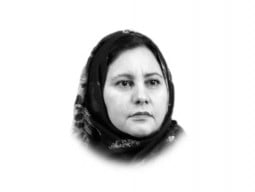
Dear Jamil Naqsh Sb,
I didn't have a chance to meet you in person, but was fairly introduced to your brilliance with brush and paint in capturing the female figure. The sensuous, gratifying female form often composed alongside pigeons, doves and horses was found erotic by most in Pakistan. I shall say that beauty lies in the eyes of the beholder and meaning and implications of visuals come from one's own psyche otherwise these birds and animals symbolise peace, grace and elegance and nothing else.
I am writing not to analyse your work but to congratulate you on challenging the authority of the Westerners, specifically British archaeologist Sir Mortimer Wheeler, in naming the Indus lady as 'Dancing Girl'. I believe in the African saying that every story glorifies the hunter unless the lion gets to speak. You proved to be the lion and gave the lady a new name, the Fisher Woman. Not bad, but the romanticist in me prefers Tarar Sb's fantasy who came up with proper names - Paroshni, Pakli or Kaagri - annotating her as an individual, not a category or a type.
The little lady, four inches in height, was dislocated during the 1947 Partition. Like other assets, the artifacts were to be divided amongst India and Pakistan. The famous Priest King and the Fasting Buddha who were visiting India with her for an exhibition at the time returned to Pakistan but she had to let go of her home to stay in New Delhi National Museum. Perhaps women always have to make more sacrifices. It's also reported that the Pakistani 'patriarchs' specifically "asked for and received the King while India retained the Dancing Girl". Not sure if it's true but we can expect such absurdity from some of our fellows. Our very own artist and barrister Iqbal Geoffry petitioned the Lahore High Court for the return of the statue which to him was like "Di Vinci's Monalisa to Pakistan". He had also petitioned against the NY State on behalf of the trees at the Central Park - hence was not taken seriously by the authorities in the power corridors.
You would know that the statue we are talking about is one of the two bronzes excavated from the ancient site of Mohenjo Daro, cast through the lost wax technique. John Marshall, the archeologist who found the figure and was convinced of the prehistoric craftsmanship, described it as "a young girl, not more than fifteen years in age, her hand on her hip in a half-impudent posture and legs slightly forward as she beats time to the music with her legs and feet". The sculpture indeed depicts a confident, young woman adorned with a beaded necklace and bangles. We have evidence of lapidaries in the Indus region that had business with drilling and polishing the stones. I wonder if our lady owned agate, jasper or carnelian. The bangles could be of copper, clay or ivory. The ivory bangles called Chooda are still in fashion and are worn in the similar manner from wrist to upper arm. It is believed to bring prosperity and fertility to the married couple. Contrary to the female representations from the ancient cultures attributed mostly as 'mother goddesses' due to the enhanced reproductive organs, promising fertility and signifying their role as protector and nourisher, our lady is quite slim, agile and alert.
I thank you for paying tribute to the resilient women of the Indus, glorifying them through your art and highlighting the female stronghold in an ancient thriving culture. You have indeed rectified the statue and the history of the region. I shall finish my letter borrowing an American archeologist Gregory Possehl statement about the most captivating piece of art from the Indus Valley. He goes, "we may not be certain that she was a dancer but she was good at what she did and she knew it." More power to the girls out there - the dancers, the musicians, the athletes, the teachers, the artists, the potters, the farmers, the builders, the home-makers and the leaders. May they be good at whatever they wish to do and whoever they want to be!
Bano
August 2024








COMMENTS
Comments are moderated and generally will be posted if they are on-topic and not abusive.
For more information, please see our Comments FAQ